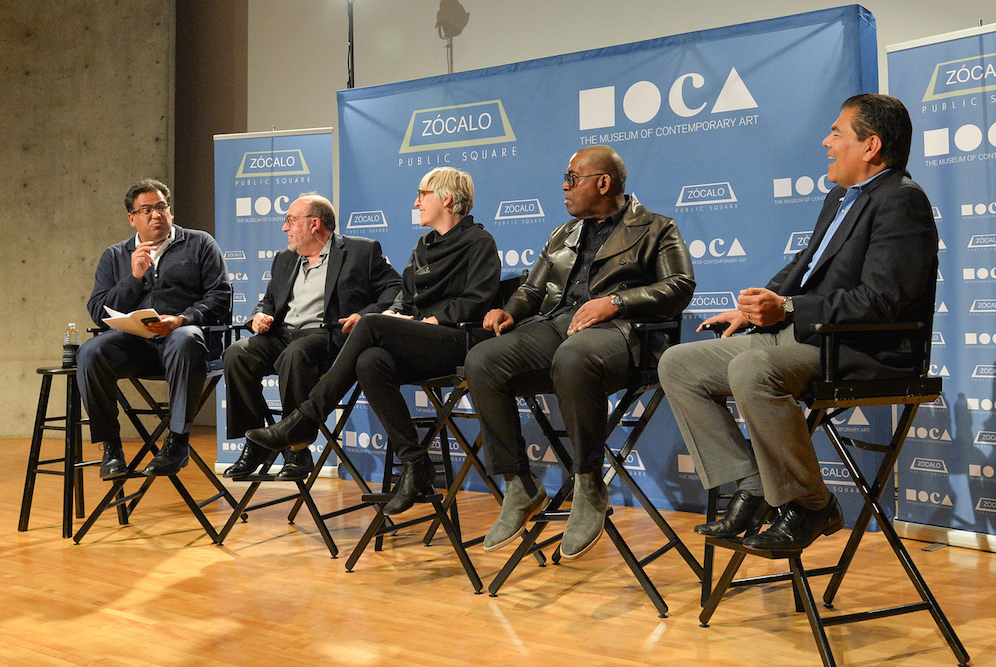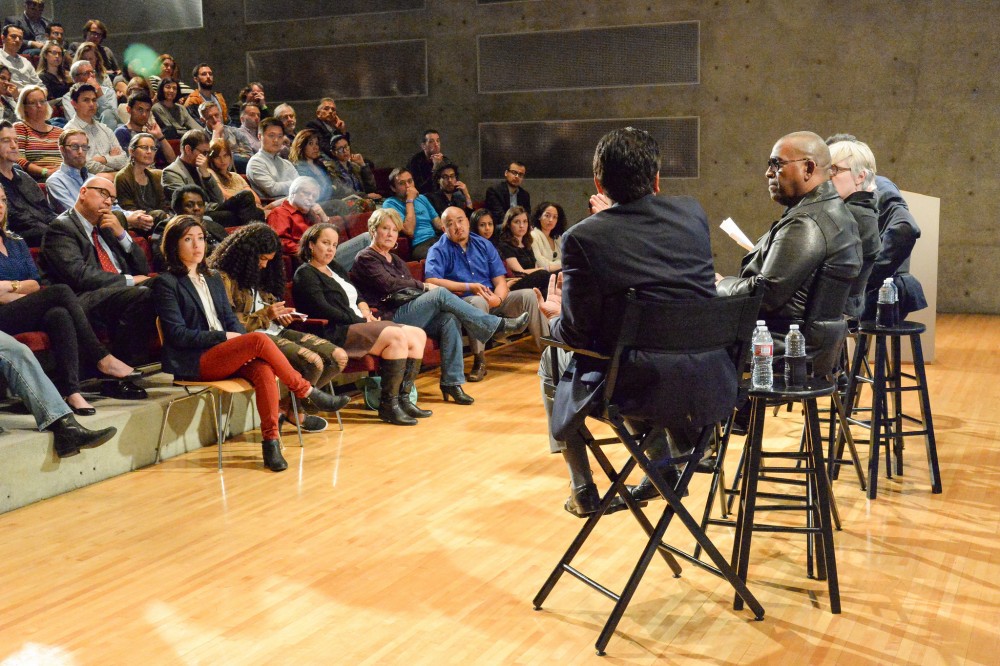
The L.A. Riots. The Northridge Earthquake. The AIDS crisis. Proposition 187. Fires. Mudslides. White flight. Recession and joblessness. The departure of the aerospace industry. The departures of the Rams and the Raiders. The OJ Simpson trial. The murder of Biggie Smalls. Gang warfare.
“The ’90s,” as Zócalo Public Square publisher Gregory Rodriguez put it, “were rough” on Los Angeles. Rodriguez was moderating a Zócalo/Museum of Contemporary Art event at MOCA Grand Avenue provocatively titled, “Were the ’90s L.A.’s Golden Age?”
Tallying up the iconic Southern California disasters mentioned by the panelists over the course of the evening, the question might seem almost laughable. “But the reaction to the roughness was pretty extraordinary as well,” Rodriguez told an energetic crowd, many of whom clearly had lived through it. “There was this sense of vitality to the era.”
While the first half of the decade “was horrendous,” said Fernando Guerra, director of the Center for the Study of Los Angeles at Loyola Marymount University, the second half marked a comeback that built the Los Angeles of today, and gave the city a greater sense of self. He recalled a UCLA professor telling him he was “parochial” for choosing the L.A. economy as the focus of his scholarship. But after watching the city nearly fall apart, almost every major institution of higher education formed a department dedicated to studying the city. “We rediscovered Los Angeles as academics in the 1990s,” he said, noting that today it can be hard to keep up with all the literature written about the city, a sharp departure from the early 1990s.
“For me, Los Angeles in the ’90s was all about culture,” recalled MOCA’s chief curator, Helen Molesworth. “When the needle dropped on NWA’s Straight Outta Compton, something shifted for me and a lot of my friends.” That was 1988, but for her it was when the ’90s began. “L.A. was all of a sudden a place where culture was made,” she said. MOCA’s 1992 exhibition “Helter Skelter: L.A. Art in the 1990s” was a landmark event, as was watching the emergence of artists like Mike Kelley and Catherine Opie, “artists to be reckoned with,” said Molesworth. “The birth of L.A. as a culture engine is really the 1990s.”
Why, asked Rodriguez, did L.A. begin to take itself seriously in the 1990s?
Hollywood had always been the producer of mainstream culture for most of America, noted Harold Meyerson, the current executive editor of The American Prospect who served the same role at L.A. Weekly throughout the ’90s. The change came thanks to growing cultural legitimacy, but also to a political evolution that resulted from the chaotic events of the first half of the decade. It was “a story of the rise of a kind of Latino working class finally finding itself, finding an identity, and finding some power,” he said. The backlash in response to Proposition 187—a ballot initiative that banned undocumented immigrants from using state services including public education and non-emergency health care—changed Los Angeles politics. It birthed a new generation of Latino activists and brought together Latinos, the labor movement, and progressives in a coalition that changed the city and eventually the state then the country, Meyerson said.
Guerra elaborated on the changes brought about by this new coalition, including bringing Latinos into positions of political power, helping Los Angeles pass a 1997 bond measure allocating $2.4 billion to the building of new LAUSD schools, and passing propositions that led to the building of mass transit for those who couldn’t afford cars.
Turning to University of Southern California race and pop culture scholar Dr. Todd Boyd, Rodriguez asked how these changes, both political and demographic—as Anglos left the city and a Latino majority emerged—manifested themselves in depictions of Los Angeles at the time.
Boyd listed a number of movies that showed “Los Angeles as a destination but also as a unique identity”: Boyz n the Hood, Menace II Society, American Me, Boogie Nights, and Short Cuts. West Coast hip-hop emerged as a major force in music during this period as well. Today, the gang activity of the time and the way it seeped into popular discourse is “safe” and “nostalgic”; Straight Outta Compton was a blockbuster movie last summer. “But at the time, the elements that make up that film were taking place in the streets,” said Boyd. “It’s one thing to sit here now and look back on it fondly. But it’s another thing to have lived in the midst of it.”
These changes weren’t necessarily in evidence in the contemporary art world at the time, said Molesworth. In “Don’t Look Back: The 1990s at MOCA,” on view at the Geffen Contemporary at MOCA through July 11, 2016, only one work makes any mention of the 1992 riots. It was made, said Molesworth, by an African-American artist in New York who was depicting a white German critic’s obsession with these events. “This was still an extremely white institution concerned with problems of whiteness,” said Molesworth. And at the time, they would not even have been called “problems of whiteness … because they were just the problems of the culture.” She added, “When we look back on the ’90s, we look through the frame of the current moment.”
As the event drew to a close, Rodriguez asked the panelists to reflect on what is better and worse about the Los Angeles of today versus the Los Angeles of the 1990s.
“There was an edge, a sense of momentum, having been through these hells,” said Meyerson.“Recovering from all this there was a certain sense of bouncing back.” He added, somewhat ruefully (and with the caveat that he is only a visitor to the city and no longer a resident), “I don’t get a sense of a kind of momentum and edge today.”
Boyd recalled visiting downtown Los Angeles before he moved here in 1992. “I just remember how amazed I was at how barren downtown L.A. was,” he said. “It was not centralized, and there really wasn’t much going on at all.” A few years later, he decided to move downtown; people thought he was crazy. Not anymore. “This has become the hottest part of L.A. To go from it being barren and nothing to being crowded with traffic, multiple cultural options, multiple dining options, to have witnessed this and to have had it grow up around me—is one of the most interesting changes to L.A.,” he said.
Before turning the discussion over to an audience question-and-answer session that touched on the decline of Westwood as a destination and the problem of homelessness from the 1990s to the present, Rodriguez turned back to the central question of the evening: “I think we can conclude that while we had an edge and sense of momentum in the 1990s, it was not L.A.’s golden era.”





Send A Letter To the Editors